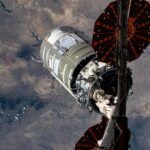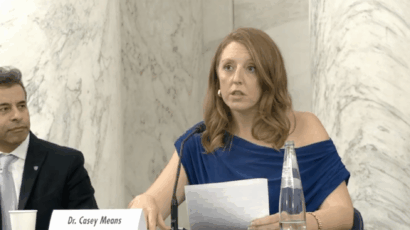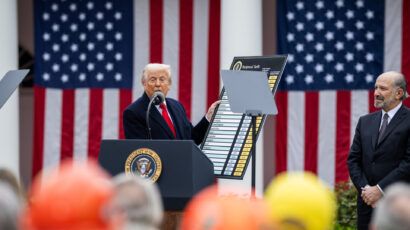Deciphering NNSA’s Complex Transformation
By Ingrid Drake, Peter Stockton | June 23, 2008
To draw attention to Complex Transformation, its “vision for a smaller, safer, more secure, and less expensive nuclear weapons complex,” in January, the National Nuclear Security Administration (NNSA) announced that it had begun removing Category I and II special nuclear materials (SNM) from Lawrence Livermore National Laboratory to the Savannah River Site–a task that the NNSA anticipates completing by the end of 2012 and would result in one less location for this dangerous material to exist.
While the Project On Government Oversight (POGO) was pleased to see some movement, it’s highly critical of the timeframe. (Full disclosure: Both of us are POGO staffers.) In March, POGO released a report that documented how the NNSA could safely remove the material much quicker (by early 2009) and how Livermore’s current security requirements put the 7 million people who live within a 50-mile radius of the laboratory at risk. We were proven correct a month later, when news broke that mock terrorists who tested Livermore’s security succeeded in a theft scenario of stealing simulated special nuclear materials and another scenario to detonate an improvised nuclear device on the spot.1 Yet in light of this faux breach, instead of accelerating removal or training its protective force better, the NNSA began circulating weaker security requirements to sites throughout the complex.2 A top NNSA official recently claimed that the removal timeline couldn’t be accelerated because the agency faces a shortage of staff who can safely package the materials because of recent layoffs.
Such a response proves that the NNSA isn’t prepared to make the tough decisions, cuts, and priorities necessary for a “smaller, safer, more secure, and less expensive nuclear weapons complex.” In fact, despite its size, the 1,000-page, 13-pound document that details Complex Transformation contains few good ideas–its analysis narrow and prescribed and the process’s timing fatally flawed.
The NNSA’s “alternatives”
In its plan, the NNSA considers four transformation options–the no-action alternative, the distributed centers of excellence alternative, the consolidated centers of excellence alternative, and the capability-based alternative. All of these include near-term pit production, as the NNSA outright rejected the most appropriate alternative–halting pit production completely. By doing so, it’s completely ignoring the domestic and global momentum for nuclear weapon cutbacks, the fact that the need for 1 or 2 pits per year can easily be met by pits from disassembled warheads, and a November 2006 JASON’s report that details how thousands of U.S. pits have at least 75 years more reliable life to them.3
The number of pits it claims to need also seems somewhat arbitrary as the NNSA went from a request of 450 pits in 2003 to the current stated need of 125 pits with a surge capacity of 200 pits. Unfortunately, this is standard operating procedure. A recent Government Accountability Office report found that the NNSA didn’t have clear, well-defined pit production goals or consistent, comprehensive cost estimations of its pit activities. Worse yet, the NNSA doesn’t need to show how much all of this will cost because it’s not required to perform a cost analysis of the alternatives, making it difficult for policy makers and the public to determine which alternative is a sensible investment.
While the Institute for Defense Analyses (IDA) conducted a crude economic analysis of moving and modernizing major facilities last November, a significant problem with the study was that the NNSA gave it the basic assumptions. For example, the requirement was for the extreme pit production levels of 125 pits per year, with an ability to surge to 200 pits per year–apparently a backdoor requirement for the Reliable Replacement Warhead Program.4 Since the IDA team consisted of a handpicked cadre of Cold Warriors, these assumptions were never challenged.5
Also absent from the NNSA’s thinking is the idea of “warm standby,” which would address its stated need to retain the technical capacity to manufacture pits while not creating more pits. Under this concept, scientists would get a finite amount of plutonium for perfecting a prototype. They would then destroy this model, allowing them to advance their technical skills without adding pits to the stockpile, violating international agreements, or investing in additional storage.
A look at the alternatives the NNSA did consider:
The no-action alternative. A status quo option that even the NNSA thinks is a headache. Many of the current NNSA sites store special nuclear materials in decades-old buildings that were never designed to deter modern-day terrorist assaults.6 Moreover, many of these sites no longer need SNM to fulfill a national-security mission, but store them at great cost and risk. In Congress, the Office of Management and Budget, and even some Energy Department corridors, the nuclear weapons complex is regarded as being rife with programmatic and structural redundancies that exist only to spread jobs across seven states and many congressional districts.
Distributed centers of excellence. An alternative that smartly states that the Pantex Plant near Amarillo, Texas, should remain the complex’s assembly/disassembly/high explosives production and manufacturing center and that nondestructive surveillance operations also be consolidated there–a component included in the NNSA’s preferred alternative. But it doesn’t go far enough to plan for the opening of more bays and cells at Pantex to increase the disassembly rate. At the current rate, disassembly of U.S. surplus weapons will occur in 2023. There’s also no talk about expanding the storage and disassembly capabilities of the Device Assembly Facility, which is largely overlooked in Complex Transformation.
Consolidated centers of excellence. This alternative consolidates the three major SNM functions at one or two sites and says, “If Pantex or Y-12 [in Tennessee] were not selected for this option, weapons operations at Pantex, Y-12, or both sites would cease.”7 Because it would require massive expenses for cleanup, transportation, and new construction, even the IDA analysts don’t believe it’s an economically feasible option. And it would be dead-on-arrival in Congress, whose members would look foolish for appropriating billions of dollars over the years for Y-12’s Highly Enriched Uranium Materials Facility and Uranium Processing Facility. It’s also politically impossible to eradicate thousands of jobs in Tennessee and Texas.
The capability-based alternative. With language about the “basic capability for manufacturing components for all stockpile weapons,” the capability-based alternative seems to exist for deflecting the curatorship option, which offers a vastly different approach to NNSA’s restructuring plan for research and development and testing facilities.8 “Instead of relying on a massive research and development enterprise to improve scientific and technical capabilities, the curatorship approach relies upon the extensive historical testing and certification activities, which have demonstrated that the existing stockpile is safe and secure, “Tri-Valley CAREs, a Livermore-based watchdog group, explained in April.9
The curatorship option would close Livermore’s High Explosive Application Facility and all of the high-explosive facilities at Site 300; Technical Area (TA)-9, TA-14, TA-16, TA-36, TA-46, and TA-53 at Los Alamos National Laboratory; and Explosive Applications Department facilities at Sites 9920, 9930, 9939, and 9940 in Coyote Canyon and at facilities in Thunder Range at Sandia National Laboratories.
With that definition in mind, the capability-based alternative is far from curatorship, since it would still involve cranking out 50 pits per year at Los Alamos. And while “production capacities at Pantex, Y-12, and the [Savannah River Site in South Carolina] would be reduced to a capability-based level,” those levels aren’t specified.10
The preferred alternative
The NNSA’s “preferred alternative” is somewhat of a grab bag of the four alternatives. The problem is that the impacts and costs are unknown. What is clear is that the preferred alternative relies heavily on the much-maligned and congressionally circumspect Chemistry and Metallurgy Research Replacement (CMRR) Facility at Los Alamos; however, the NNSA never provides a clear explanation as to why the CMRR is needed to produce 80 pits per year.11 The weapons complex has studied plutonium for 60 years, what else is there to learn? Instead of continuing construction of CMRR, which is currently estimated to cost $2.6 billion–more than four times initially promised, other existing buildings at Los Alamos could be refurbished and expanded, i.e., the heavily protected Plutonium Facility.
And while Complex Transformation has a liberal approach to new construction, it’s ultra-conservative when setting downblending goals or declaring excess highly enriched uranium (HEU). Terrorists badly want HEU because it’s easy to turn into a crude nuclear weapon; therefore, simply put, downblending reduces security risks. There’s a major international effort underway to eliminate HEU by consolidating it and downblending it so that it’s not weapons-usable. Nevertheless, at great cost and risk, the United States is currently storing a vast majority of 400-500 metric tons of HEU in a wooden building at Y-12.
With great fanfare in 2005, the NNSA declared an additional 200 metric tons of HEU unnecessary for the weapons program. But it turned out only 20 metric tons would be downblended–most of the remainder would be stored for nuclear naval fuel. In total, since 1994, when then Energy Secretary Hazel O’Leary declared 174 metric tons of HEU excess. Since then, only 20 metric tons of additional quantities of HEU have actually been declared excess. And of that 194 metric tons, only about one-half has been downblended.
Thus, instead of declaring most of the HEU inventory at Y-12 excess and downblending it, Energy will store it at the site’s Highly Enriched Uranium Materials Facility when it’s completed in later this year. If it were downblended, adequate space would exist at the facility to accommodate the proposed functions of the Uranium Processing Facility, saving about $3.5 billion in construction costs. POGO has learned from sources at Nuclear Fuel Services in Tennessee and the Nuclear Products Division of BWXT in Virginia that they have plenty of downblending capacity. But the NNSA hasn’t used Complex Transformation to set any future downblending goals. In fact, a senior NNSA official told us during a recent meeting that downblending had nothing to do with Complex Transformation.
On the road to nowhere
While POGO submitted one of the more than 100,000 public comments to the Draft Complex Transformation Supplemental Programmatic Environmental Impact Statement (SPEIS), it seems that the NNSA is less concerned with future security priorities than with achieving its priorities before a change in administration.12 The premise from which the document was drafted is obsolete, as the 2001 Nuclear Posture Review was designed to provide direction for the U.S. nuclear forces over the next decade. It is shortsighted then for the NNSA to initiate the SPEIS before two upcoming landmark reviews–the next administration’s Nuclear Posture Review and a congressionally appointed, bipartisan commission report on the role of nonproliferation programs and missile defenses in U.S. strategic policies, which will be completed by December 1, 2008. 13 Also outdating the 2001 Nuclear Posture Review is the mounting chorus for “substantial reductions” in U.S. nuclear forces–see “Toward A Nuclear-Free World,” A World Free of Nuclear Weapons, and “What Are Nuclear Weapons For?”
The NNSA is expected to release a Record of Decision later this year. It is likely to receive a chilly reception from Congress. And Complex Transformation may receive a similar reception from the next administration, as both presumptive presidential nominees, while not offering specifics, have expressed a desire to make significant changes in the U.S. nuclear stockpile.
1An improvised nuclear device (IND) can be created at numerous Energy Department sites because of the presence of special nuclear material in weapon-grade quality and quantity. Creating an IND with highly enriched uranium (HEU) is fairly simple. Creating an IND with plutonium is significantly more difficult. INDs can cause nuclear detonations of varying sizes, and with the right explosives equipment, little time is required to accomplish such an act. An IND explosion is qualitatively different from a “dirty bomb,” also known as a dispersal device. Detonating plutonium or HEU with an explosive would cause a major dispersion of highly radioactive materials, but an IND explosion could cause a chain reaction.
2To make matters worse, Livermore was tested against the 2003 Design Basis Threat (DBT), which consists of half the attackers contained in the 2005 DBT. Livermore was supposed to have been able to test against the 2005 DBT in 2008, but it received a waiver from the NNSA. The DBT describes the level of threats a protective force is required to defend against–the number of outside attackers and inside conspirators, as well as the types of weapons and size of truck bombs available to terrorists. It’s based on the Postulated Threat, which the Defense Intelligence Agency, FBI, CIA, Energy Department, and Defense Department developed.
3For the dates of original manufacture of the pits, see The Modern Pit Facility, American Physical Society Panel on Public Affairs, April 2004.
4The U.S. nuclear weapon laboratories are making a new argument for designing and producing replacement warheads with newly manufactured pits–dubbed the Reliable Replacement Warhead (RRW) Program. The replacement warheads would supposedly be safer, more secure, simpler in design, and use less toxic materials–except for plutonium. The core underlying argument for RRW seems to be that, in order to maintain the capability to design new warheads, the weapon laboratories must continue to do so even if new warheads aren’t needed, J. Medalia, “Nuclear Warheads: The Reliable Replacement Warhead Program and the Life Extension Program,” Congressional Research Service Report RL33748, January 30, 2007. But even if that argument is accepted, it doesn’t mean that the new warheads must be manufactured in quantity. Greg Mello at the Los Alamos Study Group has also provided excellent analysis.
5James P. Woolsey, Robert W. Selden, John S. Foster, and Robert B. Barker, Institute for Defense Analyses, “Economic Analysis of National Nuclear Security Administration (NNSA) Modernization Alternative,” IDA Report R-411, November 2007.
6Special nuclear material is plutonium and highly enriched uranium categorized into Security Categories I, II, III, and IV based on the type, attractiveness level, and quantity. Categories I and II require the highest security level.
7National Nuclear Security Administration, “Draft Complex Transformation Supplemental Programmatic Environmental Impact Statement Summary,” DOE/EIS-0236-S4, p. S-16, December 2007.
8Ibid.
9Tri-Valley CAREs, “Public Comment and Analysis Part One: The Nuclear Weapons Complex-Wide Impacts,” Page 8, April 30, 2008.
10“Draft Complex Transformation Supplemental Programmatic Environmental Impact Statement Summary.”
11In 2006, the House Appropriations Committee called NNSA’s endeavor “irrational.” Energy and Water Development Appropriations Bill, House Appropriations Committee Report 109-474, p. 109, 2006.
12“Draft Complex Transformation Supplemental Programmatic Environmental Impact Statement Summary”; since our October 2001 report, “U.S. Nuclear Weapons Complex: Security at Risk,” POGO has closely followed NNSA’s efforts–and lip service–to consolidate the complex.
13National Defense Authorization Act for Fiscal Year 2008.
Together, we make the world safer.
The Bulletin elevates expert voices above the noise. But as an independent nonprofit organization, our operations depend on the support of readers like you. Help us continue to deliver quality journalism that holds leaders accountable. Your support of our work at any level is important. In return, we promise our coverage will be understandable, influential, vigilant, solution-oriented, and fair-minded. Together we can make a difference.
Topics: Nuclear Weapons, Opinion















